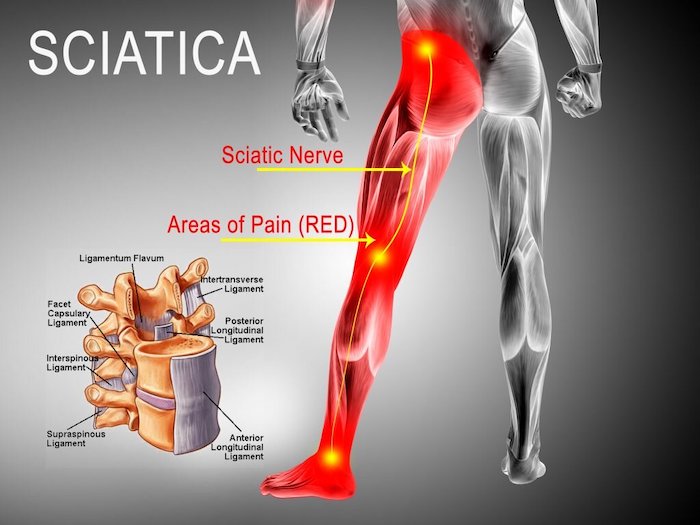
An appointment with your doctor to discuss your sciatica symptoms and treatment options can often feel like a race against time.
With many consultations lasting 15 minutes or less, here are 6 insights and tips on how to make the most of your time with your doctor:
1. Write Down Your Symptom History to Save Time During the Appointment.
Your doctor is going to ask you several questions about your symptom history, so writing it down in advance will save time during your appointment and ensure you don’t leave out any important information. When you have a well-maintained pain diary, you will likely provide more precise and complete information, and avoid missing important symptoms or factors that can be crucial in your diagnosis.
Symptom-related questions your doctor is likely to ask you:
- How would you describe your symptoms like the pain throbbing, searing, electric-like, or dull and localized?
- Do your symptoms extend below the knee?
- How long have you had these symptoms?
- Are they getting worse or staying the same?
- What causes a flareup in your symptoms (activities, sports, inactivity, sitting for prolonged periods, etc.)
- Do you have neurological symptoms, such as difficulty in lifting your foot (foot drop), numbness, or weakness?
- Does a specific position offer temporary relief or aggravate the pain further? For example, does bending forward make your symptoms better (maybe spinal stenosis) or worse (maybe a herniated disc)?
Maintaining a pain diary can be helpful when you have sciatica. The diary doesn’t have to be an actual book use the notes app on your phone so that you can have the information accessible at all times. Make a note every time you experience a symptom of sciatica write down the type, severity, and duration of the symptom.
2. Understand the Medical Vocabulary in Advance.
Sciatica is a lay term that describes a set of symptoms that originate in your lower back and travel down your sciatic nerve. There are specific terms associated with sciatica and learning the vocabulary ahead of time can help you save time and avoid confusion during your consultation.
Commonly used medical terms are:
- Nerve root. Several spinal nerves branch off your spinal cord at different levels. A nerve root is the part of the spinal nerve that leaves the spinal cord, passes through a bony opening, and exits the spinal canal.
- Radicular pain. This pain originates from the spinal nerve roots. In sciatica, radicular pain may occur when one or more nerve roots from L4 to S3 are inflamed, irritated, or compressed.
- Lumbar/lumbosacral radiculopathy. This term refers to neurological deficits, such as numbness or weakness that typically accompany radicular pain in sciatica.
Your doctor may use these terms to describe the underlying cause of your sciatica.
3. Find A Doctor with Extended Appointments.
Certain doctors offer special, extended appointment times, sometimes as long as 1 hour or weekend appointments (also referred to as concierge service). Other doctors offer extended times for all patients as a part of their regular schedule.
Don’t limit yourself to a single doctor; feel free to shop around for someone who offers extended appointments. To find out if a specialist offers such benefits in your area, peruse the websites of various medical practices or talk with your primary care doctor.
4. Bring A Friend to Your Sciatica Appointment.
If your sciatic pain is severe, it may be difficult to concentrate. Bringing a friend or family member to your appointment to take notes can allow you to focus on the conversation with your doctor without having to worry about forgetting something later.
A friend can also help you prioritize your discussion topics and ensure you don’t forget to talk with your doctor about an important matter.
5. Ask About Specific Red-Flag Symptoms.
While rare, certain types of sciatic nerve pain may indicate a medical emergency and require immediate treatment. Ask your doctor if there are specific red-flag symptoms that you need to look out for. Understanding these symptoms can help you make a timely visit to the doctor and prevent serious complications.
As a general rule, if you have worsening neurological signs and symptoms, if neurological deficits occur in both legs, if you have bladder or bowel incontinence, or if symptoms occur after an accident or trauma, you should seek immediate medical attention. These signs and symptoms may indicate serious medical conditions such as cauda equina syndrome, which must be treated on an urgent basis to preserve leg function.4
6. Bring Your List of Medications and Previous Medical Records.
Provide an accurate history of your medical and surgical treatments and bring all your test results or relevant documents that you may have received from previous doctors. These details are crucial in deciding your course of treatment and also save the time and effort to conduct new tests.
Consulting a doctor will provide you with a greater benefit if you’re well prepared. With these tips, you can more actively participate in the diagnostic and treatment process and are more likely to find healing and pain relief.
Precision Pain Care and Rehabilitation has two convenient locations in Richmond Hill – Queens and New Hyde Park – Long Island. Call the Richmond Hill office at (718) 215-1888, or (516) 419-4480 for the Long Island office, to arrange an appointment with our Interventional Pain Management Specialist, Dr. Jeffrey Chacko.













